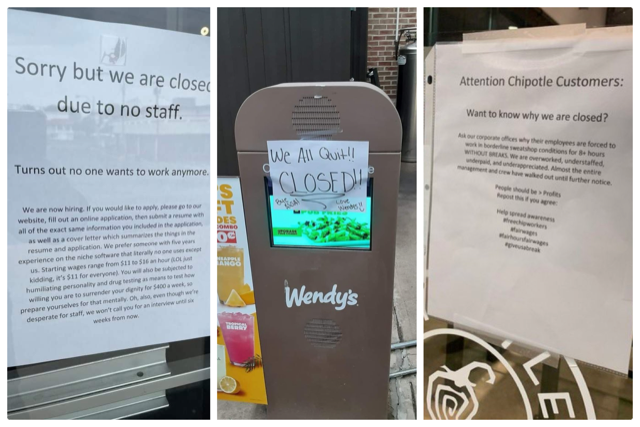“We Are Closed.” Are people lazy? No, eyes are beginning to open


“We are closed. Nobody wants to work anymore,” is plastered on doors and windows of businesses across the nation. Photos of franchises and businesses closing are circulating around social media. But are you falling prey to “believing” what you are reading, or are you thinking for yourselves about what’s really going on? Dig deeper.
These posts have sparked immediate conversation surrounding minimum wage, and as more and more businesses close, it looks like an unofficial “woke” worker’s strike is taking place.
So why are minimum wage employees “striking?” The closed businesses seem to think that it is because nobody wants to work anymore and that the employees are lazy, but the employers may need to consider that people are not willing to work for poverty-line wages while risking their lives during a poorly-managed pandemic.
According to an employment platform, Joblist, 30% of restaurant workers are switching from the industry, and the interest in restaurant jobs have fallen by 40% since June 2020.
One Fair Wage, an organization advocating for livable wages, reported that 76% of restaurant workers cite poverty wages as the reason for leaving the restaurant industry.
40% of restaurants found it difficult to find cooks, cashiers, and other restaurant positions.
While it may seem obvious that restaurants are suffering from a wage shortage rather than a worker shortage, restaurant CEOs are blaming federal pandemic relief benefits for being too abundant and accessible.
CEO Robin Gagnon of We Sell Restaurants thinks that the decline of workers in the restaurant industry will continue unless the relief benefits, such as unemployment benefits, are taken away.
“The main issue is the federal enhanced unemployment benefits,” said Gagnon in an interview with restaurant analysis platform, QSRweb. “While well intended, this is having a tremendous impact on the industry since restaurant workers literally make more money staying home than taking a job.”
That seems to be the issue doesn’t it? Why should full time restaurant workers return to businesses that refuse to pay livable wages over the opportunity to support themselves, their family, and to cross over into other industries?
It’s been over a decade since the federal minimum wage increased to $7.25 an hour. According to CBS News, the cost of living in America has since risen by 20% and housing and healthcare have increased even more.
The average price of rent in 2009 was $1,064 while the average price in 2021 is $1,477.45 a month, which is almost 30% higher than the median rent in 2009.
The Census Household Pulse Survey reported that almost 6 out of 10 workers who earn less than $25,000 annually have suffered from a loss of income since March 2020, compared to 3 out of 10 people who earn more than $200,000 a year.
Raising the federal minimum wage would support BIPOC workers. The Economic Policy Institute reported that in 2019, Hispanic workers were paid 10.8% less than white comparable workers, and Black workers were paid 14.9% less than their white counterparts.
An analysis by EPI shows that raising the minimum wage to $15 an hour by 2025 would relieve large amounts of racial pay inequality.
While the pay increase would benefit only 18.4% of white workers, 31.3% of Black workers and 26% of Hispanic workers will receive an increase in pay.
Women of color, who are most disproportionately underpaid, would largely benefit from the minimum wage raise, with 22.9% of those recipients being Black and Hispanic women.
An increase in federal minimum wage is long overdue. These strikes are just the inevitable outcome of the exploitation of restaurant and essential workers. Rather than dismissing poverty wages and its effects on employees as not wanting to work, companies would benefit from paying wages equal to the amount of work and risk employees are exposed to. Employees “not wanting to work” is also a gross lie considering multiple reports, including a report from Yale, which shows that workers receiving unemployment benefits have returned to their jobs at the similar rate as others.
